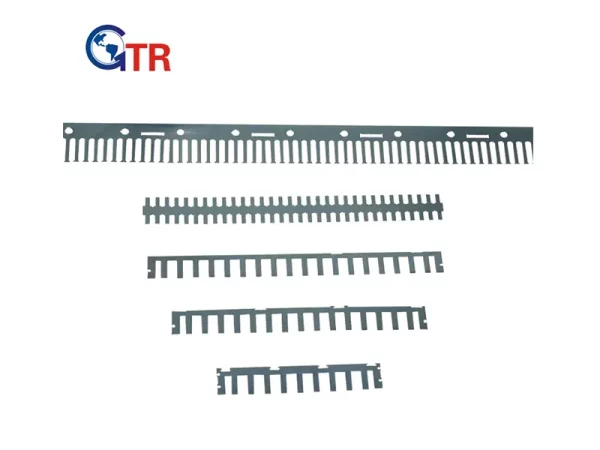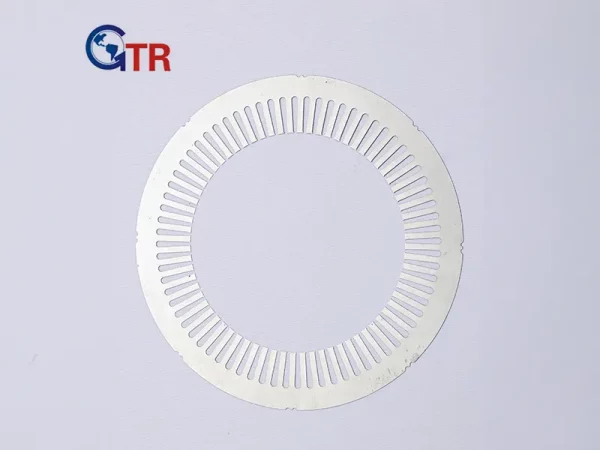Motor lamination thickness is crucial for the efficiency and performance of electric motors, especially in applications like electric vehicles, industrial machinery, and power generation.
Thinner laminations reduce energy losses, particularly from eddy currents, while thicker laminations improve the motor’s mechanical strength. The key is finding the right thickness to balance efficiency, performance, and durability.
What Are Motor Laminations?
Electrical steel is used to make thin sheets for electric motor cores, such as stator and rotor laminations. These laminations are isolated to prevent eddy currents, which flow in loops within the core when subjected to a fluctuating magnetic field. Improving motor efficiency by reducing heat loss requires lowering eddy currents.
Laminations act to limit the path of these circulating currents. The resistance to eddy current flow is increased by thinner laminations, which lowers the corresponding energy losses. However, thinner laminations can lead to higher mechanical stress in the core, which in turn, can increase heat generation and reduce the mechanical strength of the motor.
On the other hand, thicker laminations can provide more structural support to the core and reduce heat generation, but they also lead to increased eddy current losses. The key to designing a high-performance motor lies in finding the ideal lamination thickness that balances these opposing factors.

The Role of Eddy Current Losses
Eddy’s current losses are a major consideration in motor design. These currents generate heat within the motor core, reducing efficiency. The relationship between lamination thickness and eddy current loss can be expressed mathematically:
Peddy=B2 .f2. .d2/p
Where:
- Pedd is the eddy current loss,
- B is the magnetic flux density,
- f is the frequency of alternating current,
- d is the lamination thickness,
- ρ is the resistivity of the material.
As the formula suggests, eddy current losses increase quadratically with the lamination thickness. Therefore, using thinner laminations can significantly reduce these losses. In high-efficiency applications like electric vehicles, motors with thinner laminations are preferred to minimize energy loss.
However, this comes with challenges such as heat buildup and structural weakness, especially when used in high-torque applications.
The Effect of Lamination Thickness on Motor Efficiency
Motor efficiency is directly impacted by the thickness of the laminations used. The optimal lamination thickness varies depending on the specific application and operational conditions of the motor.
Thin Laminations for Higher Efficiency
Thinner laminations are advantageous for motors that prioritize high efficiency, like those found in electric vehicles or renewable energy sources. Thinner laminations limit the path available for eddy currents to flow, reducing their impact and, by extension, the motor’s energy losses.
However, this also means more precise manufacturing and more sophisticated cooling systems to manage the additional heat generated.
Thicker Laminations for Durability
In applications where motor durability and mechanical strength are paramount—such as industrial machinery or heavy-duty equipment—thicker laminations are often used.
While these thicker laminations do result in higher eddy current losses, they enhance the overall structural integrity of the motor, allowing it to handle more mechanical stress. These motors often run at lower speeds, where the impact of eddy currents is less pronounced compared to high-speed applications.
Table: Effect of Motor Performance on Lamination Thickness
| Lamination Thickness (mm) | Eddy Current Loss (W) | Efficiency (%) | Heat Generation (W) |
| 0.2 | 15.4 | 96.5 | 6.8 |
| 0.3 | 22.1 | 94.8 | 9.4 |
| 0.4 | 30.3 | 92.4 | 13.5 |
| 0.5 | 39.7 | 89.9 | 17.6 |
As shown in the table, a thinner lamination (0.2 mm) results in lower eddy current losses and higher efficiency. There is a trade-off, though, as heat generation rises and may necessitate further cooling measures.
Factors That Influence Optimal Lamination Thickness
Finding the ideal lamination thickness requires consideration of a number of parameters. Among these are:
- Motor Type and Application: Electric vehicle motors, for instance, demand high efficiency, often necessitating thinner laminations. Conversely, motors used for heavy-duty industrial tasks may require thicker laminations to enhance structural integrity.
- Magnetic Material: The choice of magnetic material plays a significant role in determining the appropriate lamination thickness. Silicon steel’s advantageous magnetic qualities make it a popular material. Specialized high-performance alloys like cobalt or iron alloys can also impact lamination design.
- Speed and Frequency: The operating frequency and speed of the motor will determine the magnitude of eddy current losses. High-speed motors typically require thinner laminations to reduce these losses.
- Thermal Management: Motors with thinner laminations often require better thermal management due to the increased heat generation. Cooling systems must be optimized to prevent overheating in high-efficiency motors.
- Manufacturing Constraints: Precision in manufacturing is essential when using thinner laminations. Modern manufacturing techniques like laser cutting or high-precision stamping allow for the production of thinner, more consistent laminations, although they can be more costly than traditional methods.
The Role of Lamination Thickness in Different Motor Types
The ideal lamination thickness depends on the motor type and its application, considering factors like speed, torque, and energy efficiency. Below is an analysis of different motor types and their typical lamination thickness.
Electric Vehicle Motors:
EV motors prioritize efficiency and performance. Therefore, thinner laminations (around 0.2 to 0.3 mm) are often used to reduce eddy current losses and improve energy efficiency.
These motors also operate at high speeds and require precise cooling systems to manage the heat generated by the thin laminations.
Industrial Motors:
Industrial motors often operate under high mechanical stress and require greater durability. Thicker laminations (0.4 to 0.5 mm) are typically used to provide the strength needed to handle high torque loads without compromising structural integrity.
While the efficiency of these motors may be slightly lower, the enhanced strength ensures longer service life and reliable performance.
Household Appliances:
Motors used in household appliances, such as fans, air conditioners, and washing machines, generally use laminations in the range of 0.2 to 0.35 mm. These motors strike a balance between efficiency and cost, and their operational speed is typically lower, reducing the need for extremely thin laminations.
Table: Lamination Thickness by Motor Type
| Motor Type | Lamination Thickness (mm) | Typical Applications |
| Electric Vehicles (EVs) | 0.2 – 0.3 | Electric cars, buses, and high-efficiency applications |
| Industrial Motors | 0.4 – 0.5 | Heavy-duty machinery, compressors, pumps |
| Household Appliances | 0.2 – 0.35 | Fans, air conditioning, washing machines |
The Role of Materials in Lamination Thickness
The material of the laminations significantly influences the optimal thickness. Motor production frequently uses high-performance materials like non-grain-oriented electrical steel (NGOES) and grain-oriented electrical steel (GOES). GOES is particularly effective for high-efficiency motors, as it enhances the magnetic properties along specific grain orientations, allowing for thicker laminations without excessive eddy current losses.
However, non-grain-oriented steel is utilized in general-purpose motors. It is less expensive than GOES but requires thinner laminations to achieve similar performance.
Table: Material Type and Its Impact on Lamination Thickness
| Material Type | Optimal Lamination Thickness (mm) | Efficiency (%) | Cost Considerations |
| Grain-Oriented Electrical Steel | 0.2 – 0.4 | 96-98 | High |
| Non-Grain-Oriented Electrical Steel | 0.15 – 0.3 | 90-94 | Lower |
| High-Performance Alloys | 0.1 – 0.2 | 98-99 | Very High |
Innovations in Motor Lamination Manufacturing
Manufacturers are always looking for ways to enhance their manufacturing procedures and lamination designs in order to satisfy the needs of contemporary applications. Two primary techniques for manufacturing laminations are stamping and laser cutting.
- Stamping: This is a high-speed process used to produce large volumes of laminations. While stamping is cost-effective, it may not offer the precision required for ultra-thin laminations.
- Laser Cutting: Laser cutting provides much more precise control over thickness and dimensions, making it ideal for high-performance applications. But the process is more costly and slower.
Emerging technologies, such as additive manufacturing (3D printing), are also being explored to produce customized motor laminations, allowing manufacturers to fine-tune the thickness and material properties for specific applications.
Performance vs. Cost: Finding the Sweet Spot
One of the main challenges in designing motors is balancing performance and cost. Thinner laminations generally lead to higher efficiency but are more expensive to produce due to the need for high-precision manufacturing. In contrast, thicker laminations may reduce the cost of production, but they can lead to lower overall efficiency.
The cost of manufacturing depends on the material used. High-performance materials like GOES are more expensive than standard electrical steel but offer better magnetic properties and lower energy losses. Ultimately, the ideal lamination thickness depends on the motor’s specific needs, such as its application, speed, and the balance between efficiency and durability.
Conclusion
Motor lamination thickness affects motor efficiency, performance, and durability. The right thickness depends on the motor’s use, material, and conditions. High-performance motors, like those in electric vehicles, need thinner laminations to reduce energy loss. Industrial motors need thicker laminations for strength. Manufacturers must balance these factors for the best performance.







